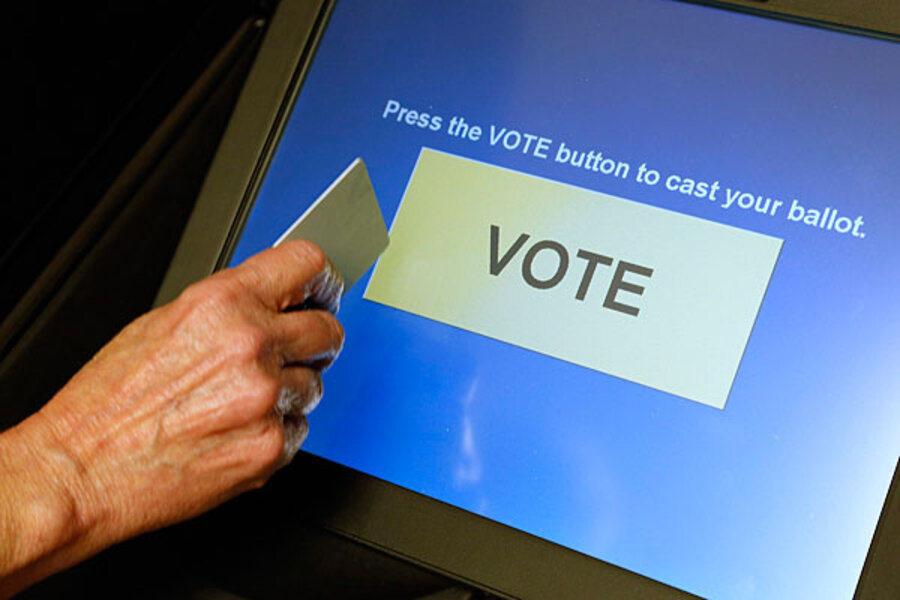Voting-machine glitches: How bad was it on Election Day around the country?
Loading...
Electronic voting-machine jams, breakdowns, and glitches were strewn across the Election Night landscape, creating long lines when machines simply broke down.
In at least one case, a viral YouTube video purported to show a Pennsylvania machine "flipping" a vote cast for President Obama into a vote for Mitt Romney.
Vote flipping occurs when an e-voting touch-screen machine is not properly calibrated, so that a vote for Romney or Obama is flipped to the other candidate. While the Pennsylvania glitch was reported and the machine reportedly taken out of service and quickly recalibrated, other flipping was reported by news media accounts in Nevada, Texas, North Carolina, and Ohio.
While flipping and other machine problems have been more prominently reported in recent elections, it's still too early to tell just how significant a role e-voting machine glitches may have played in the 2012 presidential election outcome, machine experts say.
An early Monitor analysis shows that four swing states – Pennsylvania, Virginia, Colorado, and Florida – rely to varying degrees on paperless machines.
Early reports by a team of 5,000 lawyers and 3,000 grassroots poll watchers from the nonprofit machine-watchdog group Verified Voting documented scores of cases of e-voting machine glitches. Many of the problems occurred in Virginia, Florida, Pennsylvania, and Colorado, states that still use Direct Recording Electronic (DRE) machines – touch-screen voting equipment that lack any paper backup for later recount.
Multiple reports of calibration problems with e-voting machines – the type of problem that results in vote flipping – occurred in Virginia, Nevada, Texas, North Carolina, and Ohio, says Pamela Smith, executive director of Verified Voting, a Carlsbad, Calif.-based e-voting machine watchdog group. Many more reports, however, involved too few machines at polling places, malfunctioning equipment, and "ballot presentation errors" in which poor programming resulted in electronic screen presentations of the ballot that cause voter errors.
"What we've seen in 2012 is a real throwback to the kinds of reports from some jurisdictions that we've gotten for previous elections," Ms. Smith says. "What's pretty surprising is the volume of calls we've received reporting problems. What isn't surprising is that a lot of those calls are about broken equipment – which when it gets so old you just kind of expect not to work."
Indeed, Smith and other experts have seen this before. More than 1,800 voting machine problems were reported to election protection hotlines during the 2008 general election, according to Verified Voting. Such election failures mattered far less in 2008 because Barack Obama won by a landslide. But this year, the loser might be likely to demand a recount if the winning margin is small.
Reports of voting problems include:
• In Arlington, Va., polling places were reported to be open later to accommodate lines that were 3 to 5 hours long, many because of machine breakdowns or lack of equipment, Verified Voting reported. Virginia had between 100 to 200 reports of voting system issues. (Some are categorized as polling place issues, but the majority have to do with lines and malfunctioning equipment.)
• Georgia had significant problems when electronic poll books accessed an out-of-date database of voter registration and were unable to locate eligible voters, thus forcing many voters to use provisional ballots, according to Verified Voting.
• South Carolina also had a fairly high number of reports of insufficient equipment, Smith says. A repeated concern was that, "Our polling place used to have x-number of machines, but now there were many fewer machines – and of those, half were not working" – sometimes half or even one-third the number of machines as in the past.
• Elsewhere, Wisconsin e-machine watchers reported equipment malfunctions and lines forming. And voting machines broke down in parts of Cleveland and suburban areas, including Cleveland Heights, Maple Heights and Parma, according to the Cleveland Plain Dealer newspaper. Some machines were having problems counting ballots, a problem that the Associate Press also reported in Toledo and Dayton.
Other e-voting machine watchdog groups were busy collecting information, too.
"Typically we get a huge amount of information 5 to 10 days after the election," says Bev Harris, founder of Black Box Voting, a grass roots e-voting machine watchdog group. "But already we're seeing coming in video tapes showing votes flipping to opposite candidates. In Nevada they're going from Romney to Obama and in Pennsylvania from Obama to Romney."
Colorado's secretary of state was reported to be investigating a dozen complaints that a voting machine in Pueblo had changed as many as 12 votes for Romney to Obama. But county officials said the problem hit both presidential candidates.
In a few states vote counters were reported not to be advancing when a voter voted. But most disturbing, Ms. Smith says, were reports from Ohio where there were numerous reports from voters who had their ballots cast by poll workers before they were ready. In some cases, there was a pending error message on the optical scanner that reads the votes. But the ballots were cast, instead of being returned to the voter to correct.
Jocelyn Benson, a Wayne State University professor, told Mlive Detroit, a web-based news organization, that a local vote-watching coalition had received at least 200 calls statewide about machine problems by midday, most from the downtown core.
Some e-voting machine problems were already popping up last week in early voting. A woman in Marion County, Ohio, was reportedly forced to select Romney's name several times because the machine kept flipping to Obama.
On Election Day in Pennsylvania, where the infamous YouTube vote-flipping video was taken, state officials dismissed the problem as a temporary glitch.
"There was a single complaint, so they recalibrated the machine, did a test run, and put it back online. We've had no complaints since then," Mathew Keeler, a spokesman for the Pennsylvania Department of State, told Mother Jones magazine.






